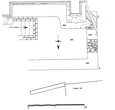Langar St AndrewArchaeology
 Earliest core fabric
is C13th Earliest core fabric
is C13th
 Central tower is
C13th - C15/16th with C19th restoration Central tower is
C13th - C15/16th with C19th restoration
 Core fabric of
nave is C13th with C15th clerestory Core fabric of
nave is C13th with C15th clerestory
 Chancel C13 Chancel C13
The Early English arcades contain some fine carving, especially around some
of the pillar capitals. The carving around the capitals near the Howe vault
is more elaborate, possibly due to improved skills as the restoration progressed
or additional funding became available. The arches are 13th century and have
dog-tooth carving on the aisle sides.
Significant Interior Features
The main door to the church contains a small wicket door in the centre and
is 14th Century. The hinges on the inside of the door show the makers mark
of William Gretton, the village Blacksmith in the mid nineteenth century.
Screen has C15th fragments but is largely C19th restoration
C18th roof:
The massive oak roof beams above the nave bear the
following inscription:
| Church Wardens |
|
William Wells
Henry Wright |
|
Sep 29
1750 |
|
Richard Wright
Henry Wright |
|
Carpenters |
 The
date being within a circle The
date being within a circle
Timbers and roofs
| |
Nave |
Chancel |
Tower |
| Main |
Ties and heavy rafters 1750 (dated) |
Pitched rafters 1855-60 |
Boarded 1855-60 |
| S.Aisle |
Low ties and rafters probably 1855-60 |
n/a |
|
| N.Aisle |
Low ties and rafters probably 1855-60 |
n/a |
|
| Other principal |
|
|
|
| Other timbers |
Rood screen C15-19th |
|
|
Bellframe
Wooden, Elphick Z, Pickford 6A, of 1859 by Taylors of Loughborough. New fittings
installed by Taylors in 1939.
Not scheduled for preservation Grade 4.
Walls
| |
Nave |
Chancel |
Tower |
| Plaster covering & date |
Plaster c.1860 |
Plaster c.1860 |
Plaster c.1860 |
| Potential for wall paintings |
Highly unlikely |
Highly unlikely |
Highly unlikely |
Excavations and potential for survival of below-ground archaeology
An archaeological watching brief was undertaken in September 2000 on the opening-up
of the north aisle wall to form a new doorway, and excavations against the
north wall to form a meeting room, toilet, and kitchen. The results concluded
that the wall almost certainly dates from the 1855-60 restoration. Excavations
revealed two inhumation burials: one adult, C19th, and one juvenille of unknown
date. Residual medieval pottery was recovered of C11th-C13th date.
Excavation plan and section relating to September 2000
work |
 Plan
of excavation area adjacent Plan
of excavation area adjacent
to north wall of Langar church |
 West
section of excavation West
section of excavation |
| Copyright: John Samuels Archaeological Consultants 2000 |
The overall potential for the survival of below-ground archaeology in the
churchyard is considered moderate and below
the present interior floors is considered to be high.
Exterior:Burials expected, multiperiod.
Areas surrounding building may be heavily disturbed by C19th restoration, though
excavations indicate residual medieval survivals.
Interior: Extent of C19th disturbance
is conjectural. Vaults known to exist and whole is likely to be a highly complex
mixture of C13th-C15th building layers with unknown survival of earlier deposits
beneath, punctuated by late medieval graves and post-medieval vaults.
Walls: Mixture of C13th-C15th,
and C19th rebuilding.
|